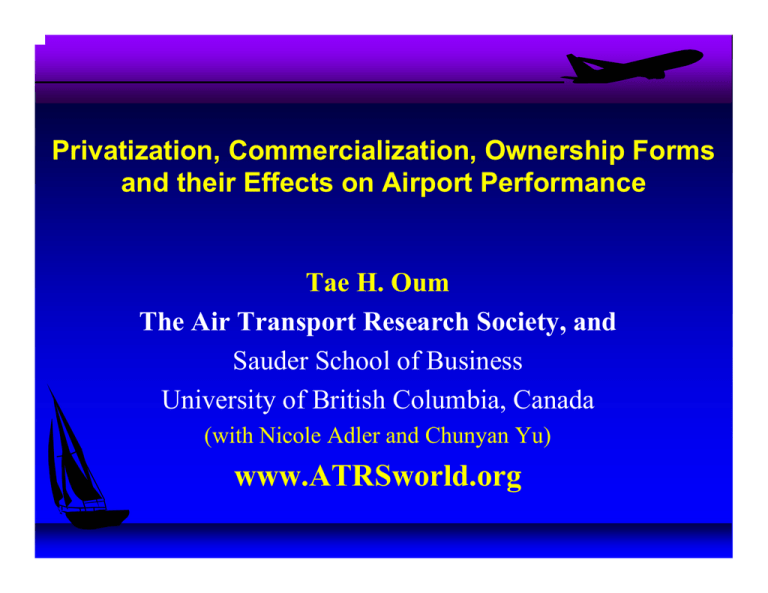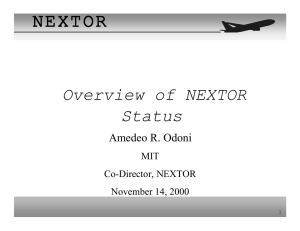www.ATRSworld.org Privatization, Commercialization, Ownership Forms and their Effects on Airport Performance
advertisement

Privatization, Commercialization, Ownership Forms and their Effects on Airport Performance Tae H. Oum The Air Transport Research Society, and Sauder School of Business University of British Columbia, Canada (with Nicole Adler and Chunyan Yu) www.ATRSworld.org Outline Introduction Privatization, Ownership and Firm Performance: – General Literature; Airports Modelling the Effects of Airport Ownership Data Sources, Sample Airports and Variable Construction Empirical Results Summary and Further Research Needs **Comments on performance of privatized ANS Introduction Worldwide Trend - Corporatization, commercialization, and privatization of airports • Access to private sector capital • To improve productive efficiency Different models of ownerships and governance: • 100% privatized • mixed ownership with private majority • mixed ownership with government majority • public corporation • independent airport authority • multi-level government corporation • Government branch ownership and operations U.S. Airports have remained mostly as government-owned and operated Objective of the Paper To examine the effects of ownership forms, and institutional structures on airport performance in terms of their productive efficiency, profit, and user charges. Literature Summary on Firm’s Performance Agency theory and strategic management literature suggest that ownership form influences firm performance because different owners pursue different goals; – design different incentives for managers; – A common view: government-owned firms are less efficient than their private sector counterparts operating in similar environment. Literature summary on firm’s performance – cont’d Government firm’s efficiency performance depends heavily governance structure, and degree of management autonomy; – E.g., Some say that many US airports enjoy high degree of autonomy, and thus, are “among the most privatized in the world”. Privatized firm’s efficiency performance depends heavily on whether or not its product market is competitive. – privatized airlines and telecom firms became very efficient since they face competitive market; – but not sure about monopoly infrastructure like airports, ANS; performance depends partly on type of regulation Modelling the Effects of Airport Ownership and Governance Structure Productivity levels as a function of: • • • • Ownership and Governance Form Management Strategy Variables Airport Characteristics and Business Environment The remainder: Technical (residual) efficiency Ownership forms investigated: government department, public corporation, independent airport authority, mixed ownership with a government majority, mixed ownership with private sector majority, multi-level government corporation. Modelling the Effects of Airport Ownership – cont’d Management Strategies – Extent of business diversification (non-aviation commercial activities) – Degree of outsourcing Airport Characteristics (beyond managerial control): – – – – Airport size Average size of aircraft Composition of airport traffic. Capacity Constraint Variable Factor Productivity (VFP) Index number approach: TFP = Output Index / Input Index VFP = Output Index / Variable Input Index * Alternative methods of measuring efficiency are being compared for our 2006 airport benchmarking report. Airport Inputs and Outputs Inputs - Labor - Other non-capital (soft cost) inputs Outputs - Aircraft movements (ATM) - Passengers handled - Non-aviation output including commercial services - (Cargo could not be included – revenue not available separately) Data Sources Airport Annual Reports and direct requests; US FAA, DOT statistics; ICAO Digest of Statistics: – annual financial data -- not for all airports ACI; IATA – annual traffic statistics – Capacity information IMF and World Bank – various price indices including GDP deflators for service sectors and PPP Selective Airport Characteristics YYZ YU L YVR JFK M IA YYC LAX EW R HNL IA D YO W SF O BO S IA H YEG YH Z O RD PH L DFW SEA DTW F LL AT L MCO C LT C VG LG A M SP BW I BN A PH X P IT M EM LAS T PA D EN RDU ST L SJ C O AK C LE DCA SAN PD X IN D MDW SLC M SY MCI SM F AM S BR U PR G G VA C IA V IE DUB ZRH C PH CDG LH R LG W W AW M AN BH X ST N M XP L IS DUS H EL MUC AR N IS T CG N H AM FCO BC N M AD O SL T XL ORY ED I A e r R ia n ta FRA BAA AN A C A A ( F IN ) AD R C AA(SW E) BER MFM H KG IC N S IN T PE NRT BKK K IX KU L AKL MNL PVG PEN D EL H KT BO M SYD PER CNS CG K PEK CHC BN E M EL HDY C AN W LG CNX AD L SEL SH A Sample airport characteristics Share of International Passengers (2003) 100% 90% 80% 70% 60% 50% 40% 30% 20% 10% 0% 0 JFK MCO ATL LAX SFO MSY MIA SEA ORD LAS DEN SAN IAH EWR DFW PHX DTW YYZ TPA MSP BWI STL FLL HNL LGA BOS YVR MDW DCA SMF SJC PHL MCI CLT IAD SLC PDX YOW YEG CVG CLE PIT OAK YYC IND RDU BNA YUL YHZ MEM LHR LGW HEL STN ORY AMS MAN CDG MAD DUB FCO IST LIS TXL MXP BCN OSL DUS HAM BHX EDI CPH MUC ARN VIE PRG ZRH BRU GVA CGN CIA WAW CAA(SWE) BAA ADP FRA Aer Rianta ANA ADR CAA(FIN) BER BNE KIX NRT ICN BKK HKG HKT SIN HDY CNX KUL TPE SEL PVG CGK PEK PER SYD MFM SHA PEN MNL CNS AKL CHC ADL WLG Sample airport characteristics Passengers per Aircraft Movement (2003) 200 180 160 140 120 100 80 60 40 20 80% 70% 60% 50% 40% 30% 20% 10% PH L M EM JFK P IT SF O M SY EW R LG A D EN YYZ ORD C LE C VG M IA ST L PD X YEG DFW IA H SEA IA D YH Z YO W YYC SLC DTW C LT DCA BW I SAN BO S M SP YVR IN D LAS MDW O AK BN A LAX PH X HNL MCO RDU F LL ATL SJC SM F YU L T PA MCI L IS W AW CGN ED I PR G C PH ZRH O SL LH R G VA AM S LG W V IE H AM STN MUC C A A ( F IN ) C AA(SW B e r lin AN A F raport AD R BAA Aer K IX NRT W LG (04) PEK T PE IC N H KG S IN ( 0 2 ) AD L SYD CHC PER SEL AKL BN E CNS AAI AO T M AH B M E L /A P A 200 180 160 140 120 100 80 60 40 20 0 JFK MCO SFO ATL LAX IAH SEA ORD DFW YYZ MIA MSP TPA LGA FLL BOS PHL CLT YVR SLC IAD CVG CLE RDU YHZ YYC LHR LGW ORY FRA AMS CDG FCO MXP OSL DUS MUC ZRH CPH EDI ARN VIE PRG HAM GVA LIS WAW NRT ICN SIN BKK HKG KIX SEL KUL PEK MEL PER PVG SYD BNE AKL WLG Sample airport characteristics Figure S-5: Aeronautical Revenue Shares (2003) Passengers per Aircraft Movement 2002 90% Europe Asia Pacific North America 0% Figure S-6 Revenue per Passenger (2003) US$ 60 50 North America 40 30 20 10 0 Europe Asia Pacific Results on Operating Efficiency -VFP Table 3: Variable Factor Productivity Regression Results – Log-Linear Model (Base ownership: airport with a private majority) Model Dependent Variable Intercept Output Scale (Index) Runway Utilization (ATM per Runway) Aircraft size (Pax /ATM) * Europe * Asia-Pacific %International * Europe * Asia-Pacific %Non Aviation %Cargo Asia Europe Oceania 2002 2003 1 VFP Coeff. t-stat 0.776 0.080 1.99 2 VFP Coeff. t -stat -0.531 0.029 0.58 3 VFP Coeff. t-stat 0.689 0.076 1.56 - - 0.101 1.71 0.045 0.80 -0.161 -0.010 0.574 0.019 -0.623 -0.453 0.410 -0.066 -0.081 1.94 0.51 9.04 0.65 4.60 3.40 2.72 1.35 1.66 -0.128 -0.008 0.565 0.021 -0.612 0.234 0.432 -0.060 -0.069 1.51 0.38 8.92 0.74 4.52 0.55 2.86 1.22 1.40 -0.303 0.599 0.628 -0.035 -0.316 0.139 0.504 0.013 -3.403 -2.720 0.508 -0.054 -0.067 3.19 3.74 2.83 1.65 1.96 3.52 7.70 0.45 3.17 3.03 3.58 1.18 1.45 Ownership/Governance Form Dummy Variables: U.S. Govt Department N. America Airport Authority 100% Public Corporation Mixed Ent. (majority-gov) Multi-Gov shareholders R2 Adjusted R2 Log-Likelihood Value Observations (n) -0.046 0.026 0.34 0.18 -0.031 0.047 0.24 0.34 -0.056 0.0176 0.44 0.13 -0.047 -0.341 -0.287 0.54 2.95 2.91 -0.038 -0.303 -0.264 0.44 2.58 2.65 -0.012 -0.225 -0.331 0.14 1.98 3.51 0.6846 0.6647 -57.27 254 0.6885 0.6674 -55.71 254 0.7336 0.7107 -35.84 254 Private majority airports focus more on commercial revenue Table 4 Ownership Form vs Shares of Non Aeronautical Revenue Groups N. American Airport Authorities Public Corporation Government majority Private-Majority Multi-Government. US Government Dept Count 78 44 14 32 16 70 Sum 35.87 21.02 5.25 18.20 8.72 34.65 Average 46% 48% 37% 57% 55% 50% Variance 0.016 0.020 0.014 0.013 0.018 0.014 Source of Variation Between Groups Within Groups Total SS 0.510 3.928 4.439 df 5 248 253 MS 0.102 0.016 F 6.447 Private majority airports achieve higher operating margin Table 5 The Effects of Ownership on Operating Margin Groups N. American Airport Authorities Public Corporation Government majority Private-Majority Multi-Government. US Government Dept Count 27 16 5 16 6 26 Sum 10.62 5.80 0.98 9.02 1.37 8.09 Average 39% 36% 20% 56% 23% 31% Variance 0.012 0.153 0.092 0.016 0.082 0.041 Source of Variation Between Groups Within Groups Total SS 0.975 4.653 5.628 df 5 90 95 MS 0.195 0.052 F 3.771 Private majority airports do not charge higher aeronautical fees Table 6b The Effects of Ownership on Airport Charges Aeronautical Revenue per Work Load Unit* Groups Count Sum Average N. American Airport Authorities 26 123.55 4.75 Public Corporation 16 125.67 7.85 Government majority 5 35.91 7.18 Private-Majority 15 90.07 6.00 Multi-Government. 5 49.56 9.91 US Government Dept 26 129.43 4.98 SS df MS Source of Variation Between Groups 206.019 5 41.204 Within Groups 1919.567 87 22.064 Total 2125.586 92 * A Work Load Unit (WLU) defined as one passenger or 100 kg of cargo. Variance 6.93 47.13 11.53 9.20 28.30 30.05 F 1.867 Empirical Results on Ownership Forms Corporatized Airports owned/operated with govt majority is less efficient than those owned by private majority or 100% gov’t corporation; NO statistical evidence indicating that airports with private majority are more efficient than airports owned/operated by US. Government departments or 100% public corporations (note: privatized airport also has monopoly power, not necessarily more efficient). Airports operated by U.S. and Canadian Airport Authorities are no more efficient than the airports operated by US government departments; Airports with government majority and airports owned/operated by multiple governments are the least efficient. Empirical Results on Ownership Forms – cont’d Airports with private majority achieved significantly higher profit margins than others, despite the fact that they generally charge lower aeronautical charges (because of their vigorous pursuit of commercial opportunities). (Airports with extensive outsourcing achieve higher efficiency) Further research: – Building more time-series data (longer panel data); – Use of alternative measurement methods such as stochastic frontier cost functions, other cost function methods, and DEA. – Structural modeling and other model-based research needed Thank You 2006 ATRS World Conference: Nagoya Japan, 26-28 May; 2007 ATRS World Conference in Asilomar, Monterey, CA – to hosted by UC-Berkeley (Mark Hansen and Nextor), 21-23 June ATRS Global Airport Benchmarking Reports – 5th Year www.ATRSworld.org


